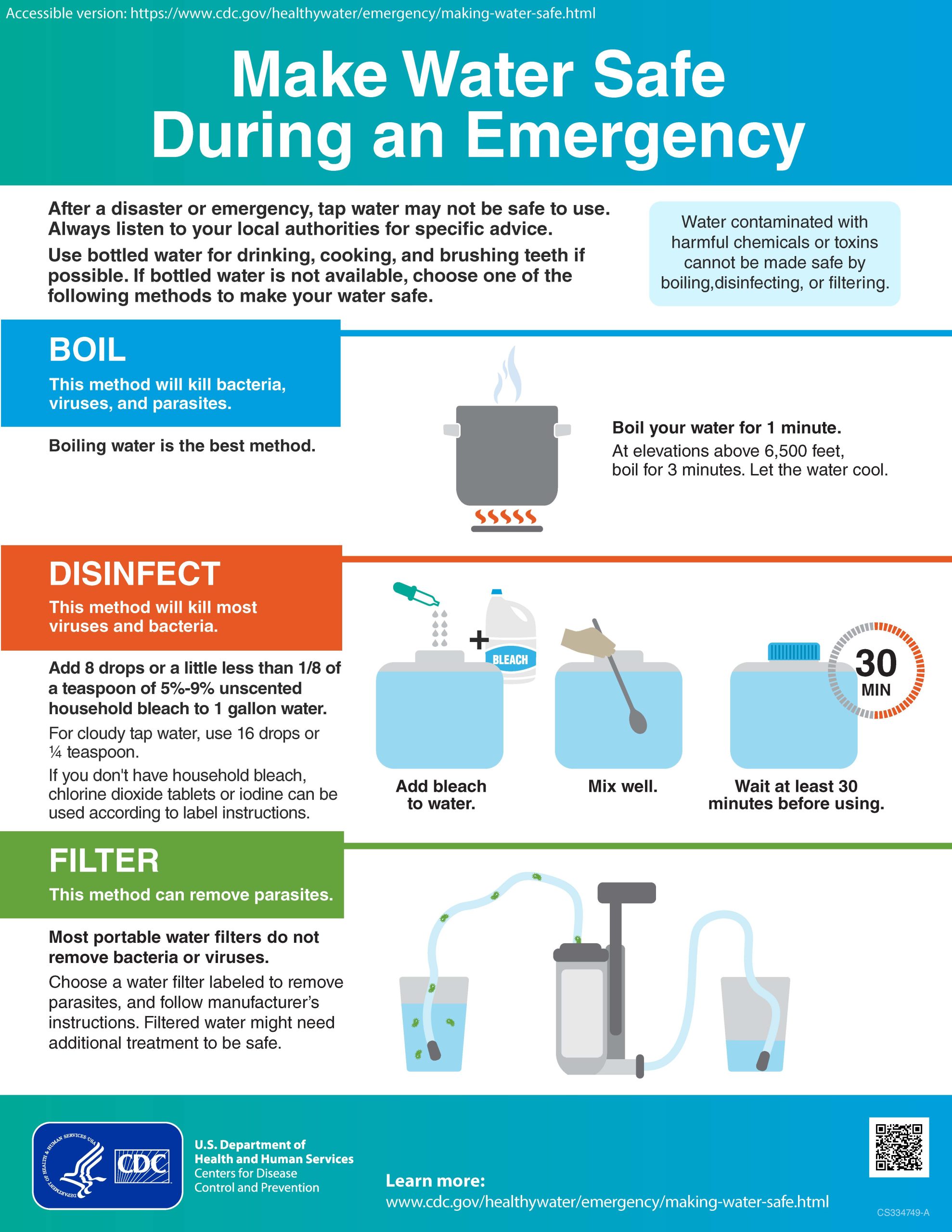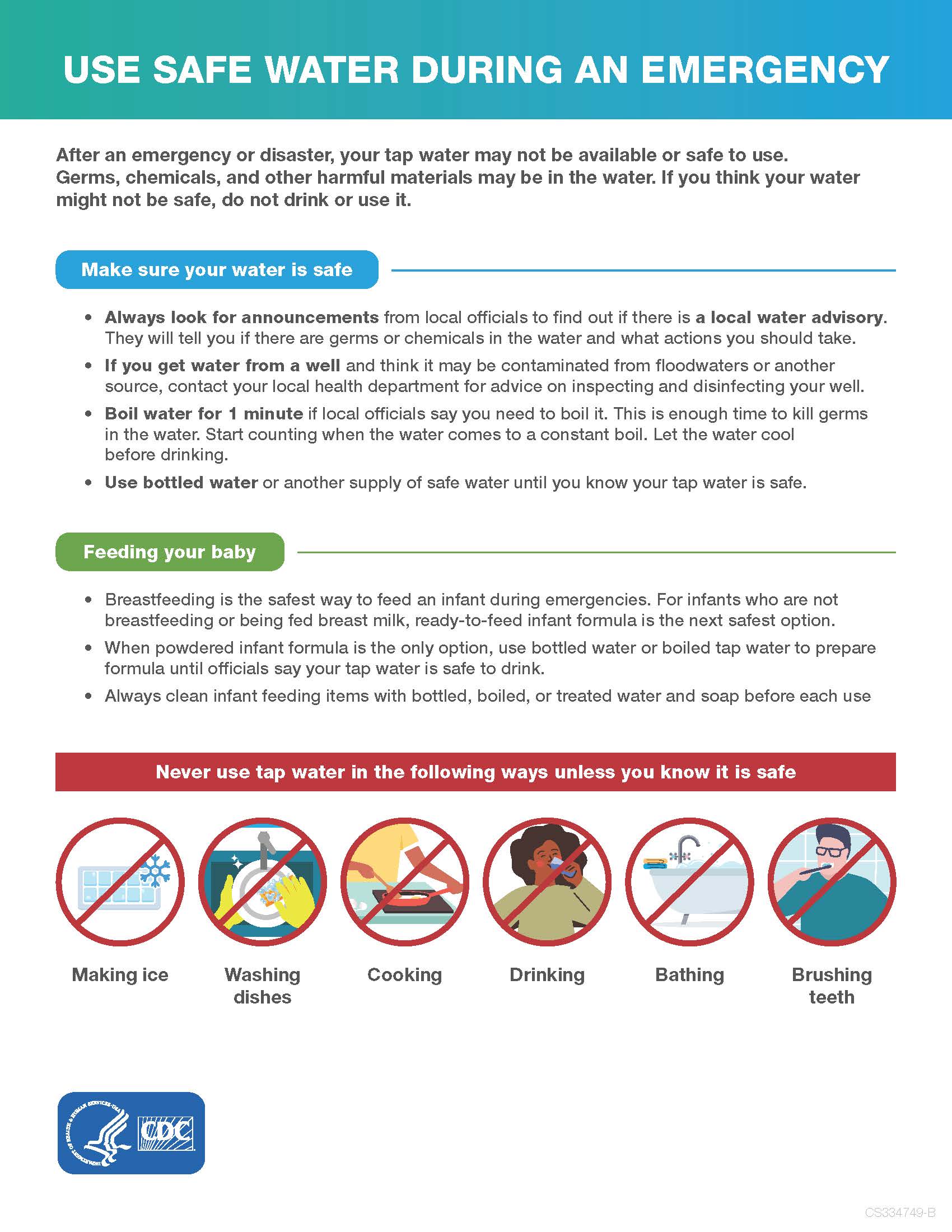Key points
- Officials issue drinking water advisories to keep people from getting sick from harmful germs or chemicals in tap water.
- Recommendations in the advisory depend on the type of germ or chemical in the water.
- Follow recommendations from officials during an advisory to avoid getting sick.

Overview
Water utilities or government agencies issue drinking water advisories if tap water is, or could be, contaminated with harmful:
- Germs (such as norovirus or Shigella)
- Chemicals (such as arsenic)
- Toxins (such as harmful algal bloom toxins)
- Radioactive materials (such as uranium)
Advisories provide specific advice about how to avoid getting sick from the tap water.
Do not use water or ice from your fridge
Terms to know
There are three types of drinking water advisories:
Boil water advisories tell you to boil your tap water before using it. Boiling kills germs in the tap water that could make you sick.
Do not drink water advisories tell you to use commercially bottled water for drinking and cooking. Swallowing chemicals or toxins in the tap water could make you sick.
Do not use water advisories tell you to use commercially bottled water for all purposes. Swallowing, touching, or having other contact with the tap water could be dangerous.
Boil water advisory
If local officials issue a boil water advisory, use commercially bottled water or boil your tap water.
Boil water advisories usually include the advice below.
Boiling water
If commercially bottled water is not available, boil your tap water. To kill germs, bring water to a full rolling boil for 1 minute. At elevations above 6,500 feet, boil for 3 minutes. To avoid burns, allow boiled water to cool before you use it.
Boil your tap water even if you filter it. For example, still boil tap water if it has been through a home water filter or a pitcher that filters water.

Drinking and cooking
Use commercially bottled water or boiled water for drinking and to prepare and cook food.
Breastfeeding is the best option for feeding an infant. If you feed your child formula, provide ready-to-use formula if possible.
Handwashing
In many cases, you can use tap water and soap to wash your hands during a boil water advisory. Follow the advice from your local officials.
Bathing and showering
Be careful not to swallow any water when bathing or showering.
Use caution when bathing babies and young children. Consider giving them a sponge bath to reduce the chance of them swallowing water.
Brushing teeth
Brush your teeth using boiled water or commercially bottled water. Do not use tap water that you have not boiled first.
Washing dishes
If possible, use disposable plates, cups, and utensils during a boil water advisory.
Sanitize all baby bottles.
Dishwashers are generally safe to use if they have a sanitizing cycle or reach a final rinse temperature of at least 150°F (66°C). Check the manual or contact the manufacturer to find out what temperature your dishwater reaches.
To wash dishes by hand:
- Wash and rinse the dishes as you normally would using hot water.
- In a separate basin, add 1 teaspoon of unscented household liquid bleach for each gallon of warm water.
- Soak the rinsed dishes in the water for at least one minute.
- Let the dishes air dry completely before using them again.
Laundry
It is safe to wash clothes as usual.
Cleaning
Clean washable toys and surfaces with:
- Commercially bottled water,
- Boiled water, or
- Water that has been disinfected with bleach
Caring for pets
Give pets commercially bottled water or boiled water that has cooled. Pets can get sick from some of the same germs as people or spread germs to people.
Caring for your garden and houseplants
You can use tap water for houseplants and gardens, including watering plants you eat.
Do not drink water advisory
Officials typically issue do not drink water advisories when tap water is, or could be, contaminated with harmful chemicals or toxins. Boiling water containing harmful chemicals or toxins will not make the water safe to use.
Do not drink advisories may include information about preparing food or drinks, making ice, washing dishes, cleaning, brushing teeth, bathing, flushing toilets, and other activities.
During a do not drink water advisory, use commercially bottled water for:
- Drinking and cooking
- Brushing teeth
- Washing fruits and vegetables
- Preparing food
- Mixing baby formula
- Making ice
- Giving water to pets
Do not use water advisory
Use commercially bottled water during a do not use water advisory. Do not drink or use tap water for any purpose as long as the advisory is in effect.
Officials issue do not use advisories when any contact with tap water could be dangerous. This includes contact with your skin, lungs, or eyes. The tap water is, or could be, contaminated with harmful germs, chemicals, toxins, or radioactive materials.
Do not use water advisories are rare.


